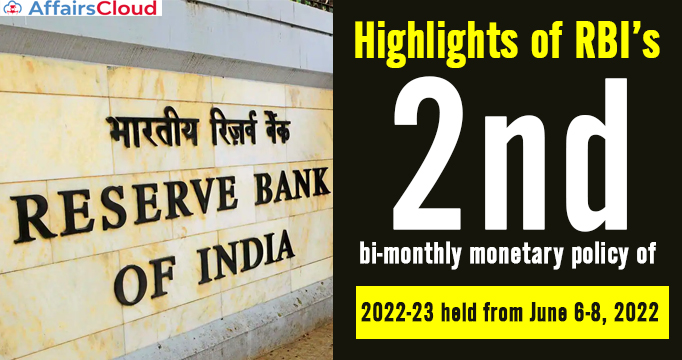
The Reserve Bank of India’s (RBI) Monetary Policy Committee (MPC) met on June 6-8, 2022 , and released the RBI’s 2nd bi-monthly monetary policy of FY23 which retained India’s real Gross Domestic Product (GDP) growth at 7.2% for the FY23 from 7.8% estimated earlier, with FY23’s Q1 at 16.2%; Q2 at 6.2%; Q3 at 4.1%; and Q4 at 4%.
- The stance is to focus on withdrawal of accommodative.
- This is the third monetary policy for the current fiscal.
RBI’s Policy Rates:
The MPC raised the repo rate by 50 basis points to 4.90% which is the biggest in more than a decade. Consequently, Standing Deposit Facility (SDF) Rate adjusted to 4.65% and Marginal Standing Facility (MSF) rate and Bank Rate to 5.15%.Reserve Ratios such as Cash Reserve Ratio (CRR) is 4.50% & Statutory Liquidity Ratio (SLR) is 18%.
| Category | Rate |
|---|---|
| Policy Repo Rate | 4.90% |
| Reverse Repo Rate | 3.35% |
| Standing Deposit Facility (SDF) Rate | 4.65% |
| Marginal Standing Facility (MSF) Rate | 5.15% |
| Bank Rate | 5.15% |
| Reserve Ratios | |
| Cash Reserve Ratio (CRR) | 4.50% |
| Statutory Liquidity Ratio (SLR) | 18% |
Inflation:
RBI raised the inflation projection by 100 basis points at 6.7% above its tolerance band of 2-6%. It was 5.7% for May 2022. The quarter inflation forecasts for FY23 are 7.5% in Q1, 7.4% in Q2, 6.2% in Q3, and 5.8% in Q4 of FY23.
- This projection is based on an assumption of average crude oil (Indian basket) at $105 per barrel during FY23, and normal monsoon in 2022.
RBI allows FSWM UCBs to offer Door-Step Banking Services
RBI allowed Financially Sound and Well Managed (FSWM) Urban Co-operative Banks (UCBs) to provide Doorstep Banking (DSB) services to their customers on a voluntary basis, at par with Scheduled Commercial Banks (SCBs). However, Non-FSWM UCBs will continue to require prior approval of concerned Regional Office of Department of Supervision of RBI to provide DSB services.
What are UCBs?
These are primary cooperative banks based in urban and semi-urban areas, and are registered as cooperative societies under the provisions of, either the State Cooperative Societies Act of the State concerned or the Multi State Cooperative Societies Act, 2002
Background:
In terms of Section 23 of the Banking Regulation (BR) Act, 1949 (As Applicable to Cooperative Societies-AACS), UCBs are required to seek prior approval of RBI for opening any new place of business including offering DSB services. With the above approval this preliminary consent is now limited to only Non-FSWM UCBs.
Key Points:
i.Eligible UCBs are required to formulate a scheme for providing DSB services by adhering to the RBI’s guidelines, and approval of their Boards.
- It will be reviewed by the Boards of UCBs on a half-yearly basis during the first year of its operation.
ii.UCBs are advised to take all necessary steps to tackle various risks related to offering DSB Services.
iii.DSB Services include Pick up of cash against receipt; Pick up of instruments against receipt; Delivery of demand drafts against withdrawal from account; Delivery of cash against withdrawal from account either against cheque received at the counter or request received through any secured convenient channel, such as phone banking, internet banking, etc; Submission of Know Your Customer (KYC) documents; Submission of Life Certificate.
Click Here for Official Notification
RBI increases Limits on Individual Housing Loans extended by UCBs & RCBs
RBI has also increased the limits for individual housing loans being extended by UCBs and Rural Cooperative Banks (RCBs) – State Cooperative Banks(StCBs) and District Central Cooperative Banks(DCCBs) by over 100%, amid increase in house prices. This increase will also facilitate better flow of credit to the housing sector.
- The limits for Tier I UCBs were revised from Rs 30 lakh to Rs 60 lakh.
- The limits for Tier II UCBs were revised from Rs 70 lakh to Rs 140 lakh.
- RCBs with assessed net worth less than Rs 100 crore:The limits have been increased from 20 lakh to Rs 50 lakh for individual borrower ;
- RCBs with assessed net worth equal to or more than ₹100 crore: The limits have been increased from Rs 30 lakh to Rs 75 lakh.
Tabular format of increased limits for individual housing loans by UCBs and RCBs:
| Category | New Limit | Old Limit |
|---|---|---|
| Urban Co-operative Banks (UCBs) | ||
| Tier I | Rs 60 lakh | Rs 30 lakh |
| Tier II | Rs 140 lakh | Rs 70 lakh |
| Rural Cooperative Banks (RCBs) | ||
| RCBs (Net worth less than Rs 100 crore) | Rs 50 lakh | Rs 20 lakh |
| RCBs (Net worth equal to or more than ₹100 crore ) | Rs 75 lakh | Rs 30 lakh |
The above limits for individual housing loans for UCBs and RCBs were last revised in 2011 and 2009, respectively.
Click Here for Official Notification
RBI permitted RCBs to Lend to CRE-RH Sector
RBI has allowed State Co-operative Banks (StCBs), and District Central Co-operative Banks (DCCBs) to extend finance to Commercial Real Estate – Residential Housing (CRE-RH) within the existing aggregate housing finance limit of 5% of their total assets. Earlier, these banks were prohibited from extending loans to the CRE sector.
- Under this permit, StCBs and DCCBs are required to maintain standard asset provision of 0.75% and risk weight of 75% for CRE-RH advances.
- Banks shall have a Board-approved policy for financing CRE-RH and a review note on the performance of the CRE-RH portfolio shall be placed before the Board at least on a half-yearly basis.
Reason behind this permit:
This decision has been taken to meet the growing need for affordable housing; and to keep them in line with the dispensation available to Scheduled Commercial Banks (SCBs), and UCBs in housing sector.
Eligible projects for Loan under CRE-RH:
i.The finance to CRE-RH will consist of loans to builders/developers for RH projects (except for captive consumption).
ii.They should not include non-residential CRE.
iii.However, integrated housing projects comprising some commercial space (for example shopping complex, school) can also be classified under CRE-RH, provided the commercial area in the residential housing project does not exceed 10% of the total Floor Space Index (FSI) of the project.
Margin Requirements for Non-centrally Cleared Derivatives
To strengthen the resilience of an over-the-counter (OTC) derivative market and in line with G20 (Group of Twenty) reforms, RBI issued Reserve Bank of India (Variation Margin) Directions, 2022 for Non-Centrally Cleared Derivatives (NCCDs) on June 1, 2022, as its first phase.
- These were issued in exercise of the powers conferred under section 45W of the RBI Act, 1934 read with section 45U of the Act, and will come into force with effect from December 01, 2022.
Now, for second phase, it is proposed to mandate the requirements for exchange of Initial Margin (IM) for such derivatives.
RBI enhances Limit for e-mandates on Credit/Debit Cards to Rs 15,000
RBI enhanced the limit for e-mandates/ standing instructions on credit/debit cards and prepaid payment instruments (PPIs) for recurring transactions to Rs 15,000 from Rs 5,000.
- This means auto-transactions up to Rs 15,000 will no longer require customers to authenticate such payments manually with one-time password (OTP).
- This will further facilitates recurring payments like subscriptions, insurance premium, education fee, etc. of larger value under the framework, and augment customer convenience.
E-Mandate Framework:
The processing of e-mandate based recurring payments on cards requires an Additional Factor of Authentication (AFA) during registration, sending a pre-debit notification. After this, these transactions are executed without AFA.
- Till date, over 6.25 crore mandates have been registered under this framework, including for over 3,400 international merchants.
RBI to modify Payments Infrastructure Development Fund Scheme
RBI also proposed to modify the Payments Infrastructure Development Fund (PIDF) scheme by enhancing the subsidy amount for micro entrepreneurs accepting digital payments, simplifying the subsidy claim process, etc.
About PIDF scheme:
Operationalized by the RBI in 2021, it is aimed at incentivizing the deployment of payment acceptance infrastructure such as physical Points of Sale (PoS), mPoS (mobile PoS) and Quick Response (QR) codes in tier-III to -VI centres and the northeastern states.
- As at April-end 2022, over 1.18 crore new touch points have been deployed under the scheme.
- It had targeted 90 lakh PoS terminals and QR codes to be deployed over three years (till end-2023).
- Beneficiaries of the PM SVANidhi (Prime Minister Street Vendor s AtmaNirbhar Nidhi) scheme in tier-I and -II centres were included under the scheme in August 2021.
RBI proposes the linking of UPI with Credit Cards; Start with Rupay credit cards
RBI also proposed to allow linking of credit cards to Unified Payments Interface (UPI). Firstly, Rupay credit cards will be enabled with this facility. This will provide more convenience to the customers in making payments through UPI platform.
Key Points:
i.At present, UPI facilitates transactions by linking savings or current accounts through users’ debit cards.
ii.Notably in May 2022 alone, around 594 crore amounting to Rs 10.4 lakh crore was processed through UPI
Members of MPC:
Dr. Shashanka Bhide; Dr. Ashima Goyal; Prof. Jayanth R. Varma; Dr. Rajiv Ranjan; Dr. Michael Debabrata Patra; and headed by Shaktikanta Das (RBI Governor).
Recent Related News:
The Reserve Bank of India’s (RBI) Monetary Policy Committee (MPC) met on April 6-8, 2022 , and release the RBI’s first monetary policy of FY23 which projected India’s gross domestic Product (GDP) growth at 7.2% for the FY23 from 7.8% estimated earlier, with FY23’s Q1 at 16.2%; Q2 at 6.2%; Q3 at 4.1%; and Q4 at 4%. The growth-oriented accommodative stance was also retained.
About Reserve Bank of India (RBI):
i.The Reserve Bank of India was established on April 1, 1935, in accordance with the provisions of the Reserve Bank of India Act, 1934.
ii.The Central Office of the Reserve Bank was initially established in Calcutta but was permanently moved to Mumbai in 1937.
iii.Though originally privately owned, since nationalization in 1949, the Reserve Bank is fully owned by the Government of India.




